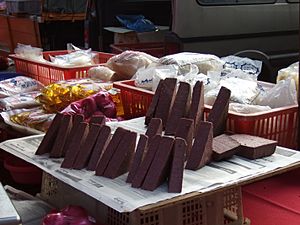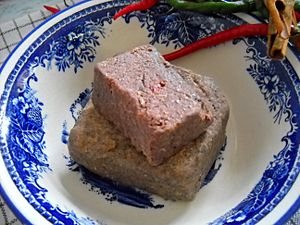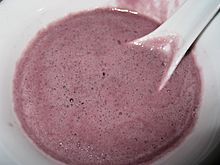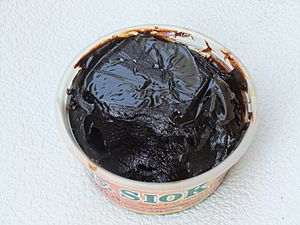Shrimp paste facts for kids

A shrimp paste in Hop Yick Market at Hong Kong
|
|
| Alternative names | Prawn sauce, trasi, terasi, belacan, Mắm tôm |
|---|---|
| Type | Condiment |
| Region or state | Southeast Asia, Southern China |
| Main ingredients | fermented shrimp |
Shrimp paste or prawn sauce is a special ingredient used in cooking, especially in Southeast Asia and Southern China. It's made from tiny shrimp or krill that are crushed with salt. This mixture is then left to ferment (change over time) for several weeks.
You can find shrimp paste sold in different ways. Some are wet, while others are dried in the sun and cut into blocks. It's a key ingredient in many curries, sauces, and sambal dishes. Shrimp paste is popular in countries like Cambodia, Indonesia, Laos, Malaysia, Myanmar, the Philippines, Singapore, Thailand, and Vietnam. People often use it as a dip for fish or vegetables.
Contents
A Look Back: History of Shrimp Paste

Shrimp paste, known as Trasi in Indonesia, has a very long history. Old writings from the Sundanese people, dating back before the sixth century, mention it. These writings tell stories about the city of Cirebon and how it used to send shrimp paste and salt as a tribute to the King of Galuh Kingdom. When Cirebon stopped sending these gifts, it made the king angry!
Trasi was a popular product from Java that traders from other islands and countries wanted to buy. A famous Chinese explorer named Zheng He even bought trasi from Cirebon and took it back to China. He helped introduce this unique ingredient to China, inspiring people there to make their own versions.
In 1707, a writer named William Dampier described trassi in his book. He said it had a strong smell but made food very tasty for the local people. He explained it was a mix of shrimp and small fish, made into a soft pickle with salt and water. This mixture was then packed into clay jars. He noted that even though the smell was strong, adding a little bit made dishes very flavorful.
Later, in the 1880s, Anna Forbes visited Ambon. She was married to a British naturalist. At first, she found the smell of shrimp paste so bad that she thought her cook was trying to poison her! She threw away what she called a "horrible rotten package." But then she realized that this "rotten stuff" was used as a spice in almost every dish she ate, whether it was local or European food.
A French diplomat named Simon de La Loubère also described a type of shrimp paste called Kapi in Thailand in 1687. He wrote that the local people used a sauce like mustard, made from "corrupted crayfish" (meaning fermented), and they called it Capi.
Different Kinds of Shrimp Paste
Shrimp paste can look very different depending on where it comes from. It can be a pale liquid sauce or a solid, dark, chocolate-colored block. In Hong Kong and Vietnam, it's often light pinkish-grey. But in countries like Myanmar, Laos, Cambodia, Thailand, and Indonesia, it's usually a darker brown. In the Philippines, it's often bright red or pink because of a special coloring called angkak (red yeast rice).
Even though all shrimp paste has a strong smell, the better quality ones usually have a milder scent. The best places to find high-quality shrimp paste are often markets near the villages where it's made. Each culture has its own version, so the smell, texture, and saltiness can be quite different.
Bagoóng Alamáng (Philippines)

Bagoóng alamáng is the Filipino name for shrimp paste. It's part of a group of fermented seafood products in the Philippines, which also includes fermented fish, oysters, and clams. It's made from the same tiny Acetes shrimp, known as alamang in Filipino. People often eat it with green mangoes, or use it as a main ingredient in cooking. It's also sautéed and eaten with white rice.
The look, taste, and spiciness of bagoóng paste can change a lot. A pink and salty bagoóng alamáng is called "fresh." This is just the shrimp and salt mixture left to marinate for a few days. It's usually cooked with other ingredients, and its flavor can be salty or even spicy-sweet. The color of the sauce also changes depending on how long it's cooked and what ingredients are added.
Unlike in some other places where the shrimp are completely broken down, in many parts of the Philippines, the shrimp in bagoóng alamáng are still visible, making the sauce chunky. A small amount of cooked bagoóng is often served with kare-kare, a stew made with peanuts. It's also a key flavor in binagoongan, a pork dish.
Belacan (Malaysia)
Belacan is a type of shrimp paste from Malaysia. It's made from small Acetes shrimp, called geragau in Malaysia. First, the krill are steamed, then mashed into a paste, and stored for several months. After fermenting, the shrimp paste is fried and pressed into hard blocks. An English writer named William Marsden even included the word "belacan" in his dictionary in 1812.
Belacan is used in many dishes. A common one is sambal belacan, which is made by mixing toasted belacan with chili peppers, garlic, shallot paste, and sugar, then frying it. Toasting the belacan helps bring out its flavor, but it also creates a very strong, distinct smell.
In Northern Australia, a version of sambal belacan is called "blachan" or "blachung." It's popular among Indigenous and Torres Strait Islander families. This is because of the influence of early traders from Makassar.
A type of belacan that is fermented for a shorter time, similar to Filipino "fresh" bagoong alamang, is called cincalok. In Sri Lanka, belacan is an important ingredient in a dish called Lamprais.
Haam Ha (China)
Haam ha is a finely ground shrimp paste popular in southeastern Chinese cooking. It's a very important seasoning in places where Cantonese people have settled. It's lighter in color compared to shrimp pastes made further south. Haam ha is a must-have in many stir-fry dishes with pork, seafood, and vegetables. Its smell and flavor are very strong. Just a tiny, pearl-sized ball of haam ha is enough to season a stir-fry for two people. Making shrimp paste has been a big industry in Hong Kong for a long time, and factories there still send haam ha to communities all over the world.
Kapi (Cambodia and Thailand)
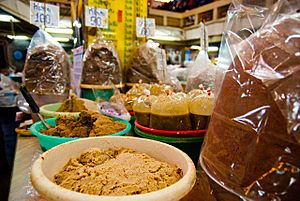
In Cambodia and Thailand, shrimp paste is called kapi. In Thailand, it's a key ingredient in many types of nam phrik, which are spicy dips or sauces. It's also used in all Thai curry pastes, like the one for kaeng som. A very popular dish in Thailand is nam phrik kapi, a spicy sauce made with fresh shrimp paste. People often eat it with fried pla thu (short mackerel) and cooked or raw vegetables.
In Southern Thailand, there are three kinds of shrimp paste: one made only from shrimp, one with a mix of shrimp and fish, and another that is sweet.
There's also something called mun kung in Thailand, which can be confusingly translated as "shrimp paste." But mun kung is actually the fat from inside the shrimp's head. It's orange, oily, and more liquid, while kapi is grey or black and more solid. Mun kung is more like a shrimp pâté.
Mắm Tôm (Vietnam)
In Vietnam, shrimp paste (mắm tôm) comes in two forms: a thick paste or a more liquid sauce. To serve it, people usually mix it with sugar, lime juice, kumquat, and chili. This makes a dipping sauce. Vietnamese people often use mắm tôm as a dip for boiled meat, fried tofu, or fried fish. They also use it to season some soup dishes, like bún mắm.
Petis Udang (Indonesia and Malaysia)
Petis udang is a black shrimp paste found in Indonesia and Malaysia. It's very popular in East Java, Indonesia. This paste is thick and black, like molasses, not like the hard blocks of belacan. It also tastes sweeter because sugar is added to it. Petis is made by boiling down the leftover bits from shrimp processing. Molasses is usually added to make it sweet.
It's used to flavor popular street foods like popiah spring rolls, Asam laksa, chee cheong fan rice rolls, and rojak salads, such as rujak cingur and rujak petis. In Indonesia, many small businesses in Sidoarjo, Pasuruan, and Gresik in East Java are known for making petis.
Terasi (Indonesia)
Terasi is an Indonesian (especially Javanese) type of dried shrimp paste. It's usually bought in dark blocks, but sometimes it's sold as a coarse powder. The color and smell of terasi can be different depending on which village made it. The color can range from a soft purple-red to dark brown.
In Cirebon, a city on the coast of West Java, terasi is made from tiny shrimp called rebon. This is where the city's name comes from! Another type is petis, made from shrimp or tuna mixed with palm sugar. In Sidoarjo, East Java, terasi is made from a mix of fish, small shrimp (udang), and vegetables.
Terasi is a very important ingredient in sambal Terasi and many other Indonesian dishes. These include sayur asem (vegetable soup with tamarind), lotek (an Indonesian-style salad with peanut sauce), karedok (similar to lotek, but with raw vegetables), and rujak (a hot and spicy fruit salad).
On the island of Lombok, Indonesia, a more savory and sweet shrimp paste called lengkare is made.
How is Shrimp Paste Made?
Shrimp paste is still made by fishing families in villages along the coast. They sell it to people who then package it to sell to customers. Shrimp paste is often known by the region it comes from, because the ways of making it and the quality can be different from village to village. Some coastal areas in Indonesia, like Bagansiapiapi in Riau, Indramayu and Cirebon in West Java, and Sidoarjo in East Java, are famous for making very good quality shrimp paste. Also, villages like Pulau Betong in Malaysia, Ma Wan island in Hong Kong, and Lingayen Gulf, Pangasinan in the Philippines are known for their fine shrimp paste.
The way shrimp paste is made can vary a lot, but here's a common method used in China and much of Southeast Asia:
- First, small shrimp are caught, cleaned, and drained.
- Then, they are dried. This can be done on plastic mats in the sun or on raised metal beds.
- After several days, the shrimp and salt mixture will get darker and turn into a thick pulp.
- If very small shrimp were used, the paste might be ready once the shrimp have broken down.
- If larger shrimp were used, the fermentation will take longer. The pulp will also be ground to make it smoother.
- This process of fermenting and grinding is often repeated several times until the paste is fully ready.
- Finally, the paste is dried again and cut into blocks by the villagers to be sold. Dried shrimp paste does not need to be kept in a refrigerator.
Where is Shrimp Paste Found?
You can find shrimp paste in countries outside Southeast Asia, especially in markets that sell Asian foods. In the Netherlands, you can find Indonesian-style shrimp paste in supermarkets that sell Asian food, like "Trassie Oedang" from the Conimex brand. In the United States, you might find Thai shrimp paste brands like "Pantainorasingh" and "Tra Chang."
Shrimp pastes from other countries are also available in Asian supermarkets and can be ordered online. It's also easy to find in Suriname because many people of Javanese background live there. In Australia, shrimp paste is available in most areas where people from Southeast Asia live.
See also
 In Spanish: Pasta de gambas para niños
In Spanish: Pasta de gambas para niños



